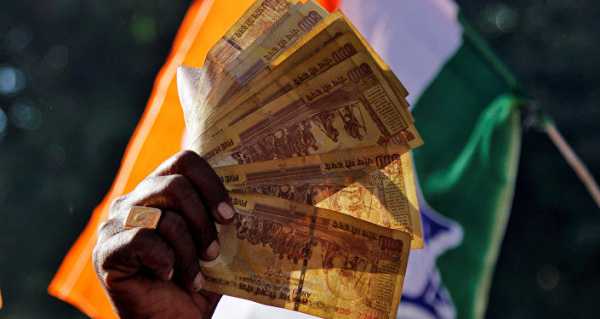
The Indian rupee has gained significantly relative to the US dollar in the last six months. Almost a month into the pandemic in April, the rupee fell to record lows against the dollar and, in a spectacular rebound, clawed back over 5 percent.
Amid a raging coronavirus pandemic over the last six months, the Indian rupee has gained phenomenally against the US dollar. From being slightly over INR 77 against the dollar in April, the Indian currency has strengthened to INR 73.58 on Wednesday. Brokerage House India Infoline said on Wednesday that renewed optimism surrounding hopes of a second economic stimulus package in the US, capital inflows and strong domestic equities are likely to help the Indian currency gain more ground relative to the dollar.
The upswing in the rupee comes at a time when the Indian economy has been marooned due to the impact of pandemic lockdowns and restrictions.
In the first quarter (April–June) of the current financial year (2020-21), which ends in March 2021, India’s Gross Domestic Product contracted an astonishing 23.9 percent, compared with the same period last year.
Experts attribute the rupee’s rebound to gains on the balance of trade, inflows from foreign institutional investors and mega investment by Facebook and Google in the Reliance Jio platforms.
Rahul K Mishra, a professor of strategy and international management at the IILM Institute of Higher Education, told Sputnik that there are a couple of reasons for the rupee’s appreciation over the past six months.
“First and foremost is the balance of payment issue. Current account deficit, which is when imports exceed exports, has come down. In fact we have current account surplus,” he said.
Pointing at reduced imports amid the pandemic as one reason for the strengthening rupee, journalist Geetu Moza, who tracks the financial and equity markets, told Sputnik: “India’s imports have come down by over 30 percent as an impact of the pandemic due to which outflow of dollar is restrained. That’s creating an oversupply of the US dollar.”
Data from the Indian government reveals that as imports slow on account of the pandemic, an oversupply of the dollar is being created in the Indian economy.
The data reveals that India’s overall trade surplus for the period of April–September stands at $17.74 billion against a deficit of $49.91 billion for the same period last year.
India imports almost 80 percent of its crude oil, which accounts for a large portion of foreign exchange cash outflow.
The pandemic lockdown and the resultant lack of demand for fuel has meant that oil imports have been impacted, thereby pushing up the supply of the dollar in the Indian economy.
Oil imports dipped by a whopping 35.88 percent, to $5.83 billion in September, compared with the same month last year. In April–September this year, oil imports dipped 51 percent to $31.86 billion.
Foreign Investments a Push to the Indian Currency
Mishra pointed out there has been an influx of the dollar beginning in April in the form of investments made by foreign investors.
“There has been an inflow of the dollars due to the investments made by Facebook, Google and others in Reliance Jio. So there’s more dollar coming in and there is less demand for the currency,” Mishra added.
Reliance Jio – the telecom arm of India’s Reliance Industries Ltd. – has raised global investments worth over $20.82 billion from thirteen global investors.
Facebook and Google also bought stake in the company, and , additionally, RIL’s retail arm is scouting for global investment.
Foreign Institutional Investors (FIIs) who liquidated their investments after the imposition of the national lockdown in India beginning 25 March, that put pressure on the Indian currency are now back to Indian equities.
In March and April, India witnessed a massive FII outgo of $8.36 billion on account of the pandemic restrictions. However, FIIs made an investment of $3 billion in the first week of June, according to data from depositories.
An estimated $6.3 billion investment was witnessed in the month of August.
Experts caution that a strong rupee is not good as it can be indicative of lack of investment in the economy and a signal that industrial and machinery imports, critical for growth, are not taking place.
The Dwindling Dollar
In the last six months, the dollar index has weakened significantly. Weakness in the index is an indication that the dollar is losing strength in comparison to currencies of those countries that are US trading partners. From a level of 100.28 at April’s end, the dollar index has come down to 92.90 as of 21 October.
A dollar index over the 100 mark indicates strength of the greenback, against other currencies while a sub-100 level of the index indicates the dollar’s weakness.
The index consists of other currencies such as the euro, yen, British pound, Canadian dollar, Swedish krona and Swiss franc. The dollar has been on a slippery slope owing to concerns over the global economic recovery, with a stimulus leading to higher fiscal deficit and near-zero interest rates over a longer duration.
During the onset of the COVID-19 pandemic, the US government signed a $2 trillion bilateral economic stimulus bill. Ahead of the elections in the US, deliberations between the US House of Representatives and the White House continue regarding a second economic stimulus, which could, according to reports, be to the tune of $1.8 trillion to $2.2 trillion.
The views and opinions expressed in the article do not necessarily reflect those of Sputnik.
Sourse: sputniknews.com
0.00 (0%) 0 votes


































